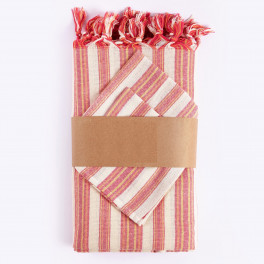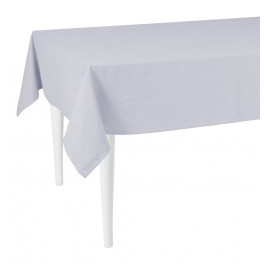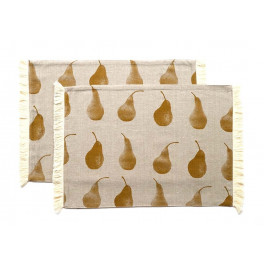Once you have dinnerware, flatware, and stemware squared away, you’ve won the triple crown of table settings. The only thing that’s left is dressing your settings up or down with the addition of table linens—and there are so many to choose from. Narrowing down the options may seem baffling at first.
Do you need a tablecloth? What about napkins? Does everything have to match? Maybe you’re not sure where to buy table linens, or what kind of material to choose. Tablecloth vs. placemats… which is better? Relax, from classic to contemporary, this helpful guide has got your table covered!
Tablecloth Magic
No one can deny the eye-popping transformative power of a tablecloth. Even the ugliest table becomes beautiful, and any table can be made to fit any occasion. When selecting a tablecloth, there are four elements to consider: color, size, shape, and fabric.
How to Choose a Tablecloth Color
Nothing looks as formal as a crisp white tablecloth. Amazingly, with the right accessories and settings, a white tablecloth can also be casual and breezy. If you buy just one tablecloth, go with white or off white. It’s a classic look that will serve you well.

Photo by Photopassjonata on Dreamstime
This doesn’t mean that colors and patterns have no place at the table. Think about the look you want to achieve. Something bright? Casual? A deep colored formal effect? Choose a shade you love in a style that complements your settings, and you’ll have a tablecloth you will definitely use.
If patterns are your thing, you might select a seasonal cloth for hosting Thanksgiving or winter holiday parties. For a subtler effect, go with a damask tablecloth—one with pattern weaving in the fabric.
What Size and Shape?
The drop of a tablecloth is the length of fabric that hangs over the edge of the table, and it plays an important role in determining tablecloth sizes. A formal tablecloth has a drop of between ten and fifteen inches, while a casual tablecloth drop is six to eight inches. If you plan on using one cloth for both, go with a drop of ten inches—better a little longer on the casual end than too short on the formal.
Don’t guesstimate your desired drop. Measure from the top edge of the table downward to the point at which you would like the overhang to end. If you’re still unsure, hang a sheet over the edge of the table and adjust it until you like the look, then measure its drop.
For a rectangular, oval, or square tablecloth, double your desired drop, then add that number to both the length and the width of your table. If your desired drop is 10 inches on a 40 X 60 inch table, add 20 inches to the width, and 20 to the length for a tablecloth size of 60 x 80 inches. For round tables, double the desired drop and add that number to the diameter. Tablecloths come in standard sizes, so you may end up plus or minus an inch or two in drop. Most packaging has a tablecloth size chart on the back to help you.
Selecting shape is pretty straightforward. The only thing that may be tricky is an oval table. Oval tablecloths aren’t as common as rectangular, square, or round. You can use a rectangular cloth on an oval table, but it will hang lower on the rounded “corners.”
What Fabric?
Cotton and linen are traditional materials for tablecloths. Both are durable, natural fibers with tight weaves. Cotton is heavier than linen, not quite as smooth, and more prone to shrinkage with laundering. Both require ironing after every use. For some people, that’s no big deal, for others, it’s a deal breaker.
As with most natural fiber fabrics, the longer the fiber, the finer the material, and the higher the price is. Both linen and cotton tablecloths are available from budget priced to high end.
Polyester tablecloths, including microfiber, generally don’t need ironing. If wrinkled by long term folding or sitting forgotten in the dryer, a quick steam job does the trick. They are available in a multitude of colors and patterns, including lace. Unlike cotton and linen, many are spill and/or stain resistant, and polyester is very affordable.
The biggest downside is polyester’s “shapeless” quality. It lacks the ultra tight weave and crispness of a natural fiber cloth. While this may not be an issue with tablecloths, it can be with napkins for classic or fancy folding.
A happy medium is the cotton/poly blend tablecloth. Yes, you’ll have to get your iron out, but it won’t be an all out press-a-thon. There’s more crispness and durability than with a straight poly tablecloth, and matching napkins will be stiff enough for folding.
Where to Buy a Tablecloth and Other Table Linens
Bed Bath and Beyond’s tablecloth selection of budget to midrange options is outstanding. Target and Kohl’s tablecloth offerings are also notable. Department stores like Macy’s and Nordstrom carryhigh end choices, but may have limited stock in store. Online vendors like Amazon can be tablecloth sources, too, but it’s always better to actually see and touch table linens before you buy.
About Those Napkins…
Most people buy their first cloth napkins and tablecloth together. White on white is a time honored formal look, and can be dressed down, too. When buying any light colored napkin, buy extra—they get stained. If you have service for eight, buy ten.

Photo by Davdeka on Shutterstock
Not into all white? Colored napkins can also be used with a white tablecloth. Contrast is one way to completely alter the look of your tablescape. You can even mix it up with multiple napkin colors on one table. Or, match them to a colored or patterned tablecloth; just beware of dark color overload. With a navy or emerald cloth, consider white napkins.
Choosing fabric for napkins has a lot to do with how you want to present them. Straight polyester is too floppy for almost all folds, but is fine rolled or in napkin rings, and rarely needs ironing. Cotton poly blends will work for the most folds, and require only light pressing. Cotton and linen napkins have to be ironed, but they fold beautifully.

Photo by besjunior on Adobe Stock
When to Use Placemats
If you have a beautiful wood or marble table top, you may opt to show it off with placemats, for formal and casual meals. Placemats tend to involve less prep and easier cleanup than a tablecloth, and are a versatile option for changing things up, even if your tabletop is plain.

Photo by ThomasPhoto on Shutterstock
Any home store, from Bed Bath & Beyond to Target, Pier 1 to Walmart, offers placemats in a plethora of colors, materials, and shapes. Most retail for $2.00 to $5.00 apiece, so they are an inexpensive way to create different looks. The three key components to consider are color, material, and shape.
Crazy for Colors
Colorful placemats can be stand out table linens when used on a bare table or over a tablecloth, in solids or patterns. If fancy dinnerware is the star of the meal, placemats should play a supporting role—think simple. Placemats can be matched to other table linens and accessories, or chosen for contrast. Buying multiple colors is a great way to give yourself options. I have the same placemats in four different colors!
Shaping Up
The two most ubiquitous placemat shapes are rectangular and round. Which you prefer is up to you, but keep fit in mind. Round placemats take up less space when planning a tight table, but may be too small for some settings. Traditionally, rectangular mats are considered more formal, but that’s not a hard and fast rule.
Oval and square placemats are less common, but may add a distinctive touch. On a contemporary table, unique placemats may be eye catching. But remember with novelty shapes that although they can be fun and beautiful, it’s a hard sell for them to be truly formal.
Material World
The best thing about most placemats is easy maintenance. Sadly, this doesn’t apply to traditional cotton and linen cloth placemats, which have to be washed and pressed. Even polyester cloth mats may need ironing, because they don’t “hang out” like tablecloths do.
For a balance of looks and convenience, the best material for placemats is polypropylene, or a polypropylene/polyester (poly/poly) blend. This is synthetic fiber that looks great, wipes or rinses clean and comes in dozens of colors, like this dark red. Some polypropylene and poly/poly placemats are made from recycled materials. Vinyl has also a come a long way, and is even available in woven options, but lags behind poly/poly in texture. It’s best used only for casual and outdoor dining.

Photo by Joanne Zhe on Dreamstime
If you prefer an option that is both low maintenance and eco friendly, try cork, bamboo, or rattan. All are beautiful examples of simple elegance, as seen in the rattan mats above, and spot clean easily. They may run a little more expensive than the poly choices, but are still in the five to ten dollar range, and are formal table approved. Sea grass, jute, and water hyacinth are also lovely choices, but are more absorbent, and thus less easy to keep clean and stain free.
Running Away With It
Many people assume that a table runner is a one trick pony, and they couldn’t be more wrong. Runners can be substituted for placemats either two at a time placed across a table, or for multiple settings placed horizontally. Both looks can work on either a bare table or over a cloth. And yes, you can also run one down the middle.

Photo by Matveev Aleksandr on Shutterstock
At a traditional formal table, the runner overhangs the edge of the table by a minimum of six inches to a maximum equal to the length of the tablecloth. Less formal and less traditional tables have more leeway, accepting runners that are shorter than or equal to the table length. If paired with a tablecloth, a runner shouldn’t be longer than the cloth (try it—it looks weird.) The width of your runner should be about 1/3 the width of your table, leaving room for place settings without overlap.
As far as colors, patterns, and materials, runners share many of the same options as placemats, and have a wide price point spread. Mixing and matching can offer a multitude of different effects. Beware of saturating your table with too many identical linens. A matched table runner and placemats set is fine on a large table, but do something different with napkins, and skip the tablecloth. Get creative and try combinations outside your comfort zone.

Photo by Iprintezis on Dreamstime
If they gave Oscars for tablescapes instead of movies, Best Table Linens would replace Best Costumes. They are definitely the most fun you can have with place settings. And whether you’re going for "Moulin Rouge," "The Great Gatsby," or "Alice in Wonderland," you can definitely put together a winner!

























